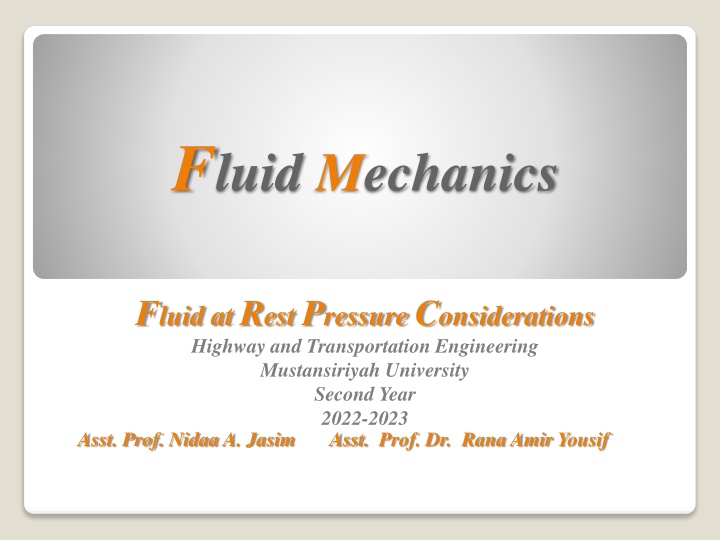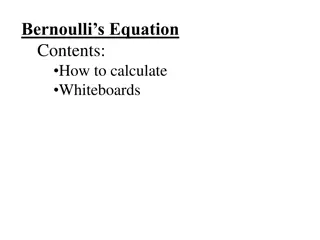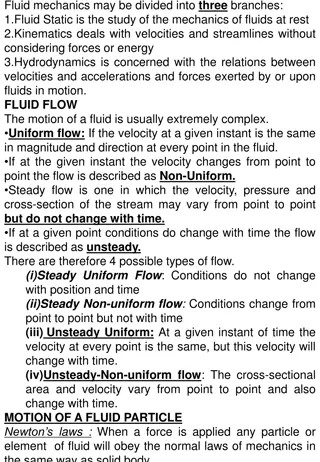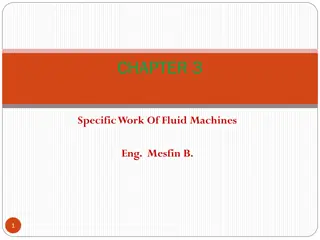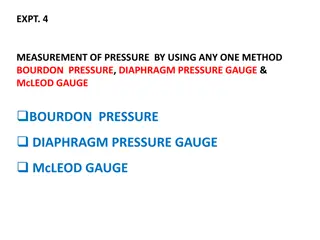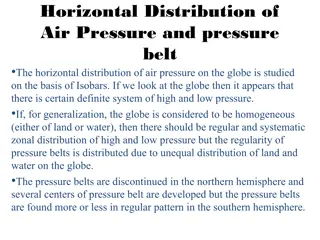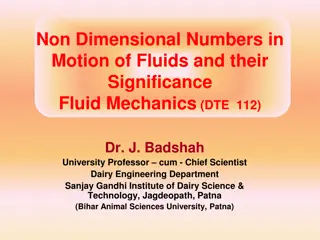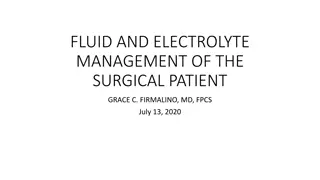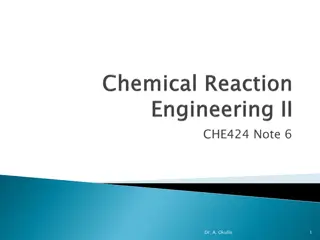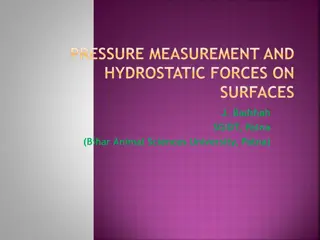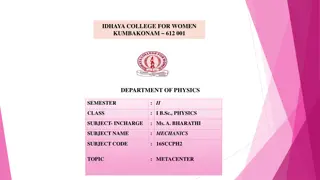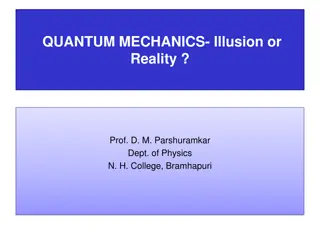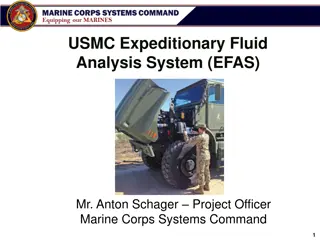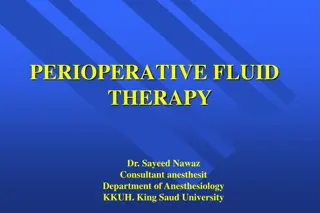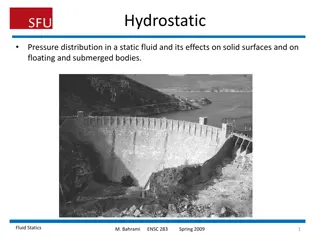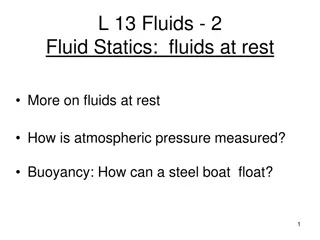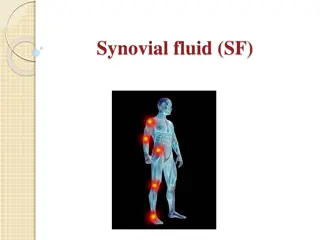Fluid Mechanics: Pressure Considerations in Transportation Engineering
Principles of fluid mechanics in the context of highway and transportation engineering, focusing on pressure at rest, Pascal's law, pressure-depth relationships, absolute and gage pressure concepts, and different types of manometers. The content includes diagrams illustrating pressure forces and calculations, helping students understand the fundamental concepts in fluid mechanics.
Download Presentation

Please find below an Image/Link to download the presentation.
The content on the website is provided AS IS for your information and personal use only. It may not be sold, licensed, or shared on other websites without obtaining consent from the author.If you encounter any issues during the download, it is possible that the publisher has removed the file from their server.
You are allowed to download the files provided on this website for personal or commercial use, subject to the condition that they are used lawfully. All files are the property of their respective owners.
The content on the website is provided AS IS for your information and personal use only. It may not be sold, licensed, or shared on other websites without obtaining consent from the author.
E N D
Presentation Transcript
Fluid Mechanics Fluid at Rest Pressure Considerations Highway and Transportation Engineering Mustansiriyah University Second Year 2022-2023 Asst. Prof. Nidaa A. Jasim Asst. Prof. Dr. Rana Amir Yousif
Pressure at Point: Pascal'sLaw Pressure acts equally in all directions at any point in static body of fluid. By referring to figure below, which shows a small cube of fluid of dimension h located at arbitrary point O within a large static body of fluid (fig.1). Where: F1 is the pressure force due to P1 upward direction. F2 is the pressure force due to P2 to the right. F3 is the pressure force due to P3 normal to the inclined surface (down and left). W is the weight of the fluid element. Fig.1
F2-F1 sin =0 P2A2-P3A3 sin =0 P2(h tan *h)-P3(h/cos *h)sin =0 P2=P1 Note That Vertical direction: F1-F3cos -W=0 P1A1-P3A3cos - V=0 P1h2-P3(h/ cos *h) cos - (0.5h*h tan )h=0 P1-P3-0.5 (h tan )=0 P1=P3 Thus P1=P2=P3
Derivation of the Pressure-depth Relationship for Liquid Fig.2 (P+dP)A-PA-dW=0 PA+dp(A)-PA- (dV)=0 A(dP)- (A*dh)=0 dP= (dh) after integration P2-P1= (h2-h1)= H Thus P= h Note That
Absolute and Gage Pressure: the Barometer Gage Pressure is measured relative to the atmosphere, whereas absolute pressure is measured relative to a perfect vacuum such as that which exists in outer space. Fig.3 below shows graphically depicts the difference between gage and absolute pressure. As Example 14.7 psi =13.6 mm Hg = 101 kpa. =10 m H2O. PA= 4.7 psia thus PA is less than atmosphere pressure. PB=24.7 psia thus PB is greater than atmosphere pressure. PA= -10 psig =10 psi suction =10 psi vacuum= -10 psi PbB =10 psig Then Pabs =Pgage + Patm. Fig.3
Manometers 1-Pisometer Tube: it is a simple type of manometer, it is a simple tube is open to the atmosphere , at the top and attached at the bottom to a pipe or other container whose liquid pressure is to be measured(fig.4). Fig.4 P1-Patm= h
2-Inclined Piezometer : it is for grater accuracy , P1=h (fig.5) Fig.5
3-U-tube Manometer: (fig.6) in this design two different fluids are used, and it can measure Suction Pressure and Larger Pressure Than A Piezometer . We start from one end and move toward the other, we use the relationship that starts that the change in pressure equals the specific weight times the change in elevation, we also note that a drop in elevation increases pressure and vice versa: Pb=Pa+ 2 h2=Pc Px=Pc- 1h1 If we use gage pressure Pa=Patm =0 gage PA + ?h2 - ?h1 = Px PA =0 (atm.) Thus Fig.6 Px= 2 h2 - 1h1
4-Differential Manometer : it is used to measure the difference in pressure between two points in a fluid system (fig.7). Fig.7 Pb=Pa+ 1h1+ 2h2- 3h3
Example 1 Find the pressure of the air above the water in the tank (fig.8) Fig.8 Pair (= PA) , PA + 9810 *(2.5+2) 13.6* 9800 * 1.5 = 0 Pair = 155400 pa. Pair =Pa=Pb-9810 *4.5 =Pb-44100 pa Pc=Pb Pd=Patm=0 gage=Pc-133*1.5 Pc=199500 pa. Patm=Pc-44.1=199500 Pair=Pc-44100=199500- 44100=155400
Example 2 Water and oil flow in two pipeline (fig.9) using the double U-tube manometer as connected ,find the pressure difference Pa-Pb? PA+ 62.4* 2 13.6* 62.4 * 2.5 + 57 * 62.4 * 1.5 = PB PA PB = 13.2 psi Fig.9 Pa=Pc-62.4*2=Pc-124.8 Pc=Pd=Pe+847*2.5=Pe+2118 Pe=Pf=Pg=Pb-57*1.5=Pb-85.5 Combining equations: Pa=Pe+2118=Pb-85.5+2118-124.8 Pa-Pb=1908 =13.2 psi.
Example 3 A U-tube manometer is connected to a closed tank (fig.10),the air pressure in the tank is 0.5 psi and the liquid is oil ( =54 lb/ft3),the pressure at point A is 2 psi. Find the depth of oil z and the differential reading h? Pa= oil *z+Pair , Z=Pa-Pair/ oil =(2-0.5)/54 = 4ft. Pa+ oil(2)-S.G.( w)h=0 , h=(Pa+ oil)/(S.G.* w) =2 144+54 2 Fig.10 3.05 62.4=2.08 ft.
Example 4 A U-tube manometer is connected to a closed tank (fig.10),the air pressure in the tank is 0.5 psi and the liquid is oil ( =54 lb/ft3),the pressure at point A is 2 psi. Find the depth of oil z and the differential reading h? 40*144+62.4(x+h)-((13.6)(62.4))h + 62.4 y=(20)(144) Fig.11 5760 + 62.4 x + 62.4 h 848.64 h + 62.4 y = 2880 5760 848.6 h +62.4 h+ 62.4 (x+y) = 2880 X+y=6 ft Thus h= 4.1 ft.
THANKS FOR LISTENING Yoder; E. J. and M. W. Witczak, Principles of Pavement Design , A Wiley- Interscience Publication, John Wiley & Sons Inc., U.S.A., 1975.
